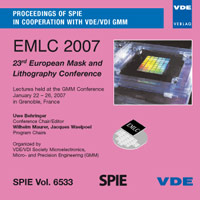Electron Beam Direct Write – Shaped Beam Overcomes Resolution Concerns
Konferenz: EMLC 2007 - 23rd European Mask and Lithography Conference
22.01.2007 - 26.01.2007 in Grenoble, France
Tagungsband: EMLC 2007
Seiten: 8Sprache: EnglischTyp: PDF
Persönliche VDE-Mitglieder erhalten auf diesen Artikel 10% Rabatt
Autoren:
Stolberg, Ines; Boettcher, Monika; Doering, Hans-Joachim; Gramss, Juergen; Hahmann, Peter (Vistec Electron Beam GmbH, Goeschwitzer Strasse 25, 07745 Jena, Germany)
Pain, Laurent (CEA Léti – MINATEC, 17 rue des Martyrs, 38054 GRENOBLE Cedex 9, France)
Kretz, Johannes (Qimonda Dresden GmbH & Co.OHG, Koenigsbruecker Strasse 180, 01099 Dresden, Germany)
Inhalt:
In semiconductor industry time to market is one of the key success factors. Therefore fast prototyping and lowvolume production will become extremely important for developing process technologies that are well ahead of the current technological level. Electron Beam Lithography has been launched for industrial use as a direct write technology for these types of applications. However, limited throughput rates and high tool complexity have been seen as the major concerns restricting the industrial use of this technology. Nowadays this begins to change. Variable Shaped Beam (VSB) writers have been established in Electron Beam Direct Write (EBDW) on Si or GaAs. In the paper semiconductor industry requirements to EBDW will be outlined. Behind this background the Vistec SB3050 lithography system will be reviewed. The achieved resolution enhancement of the VSB system down to the 22nm node exposure capability will be discussed in detail; application examples will be given. Combining EBDW in a Mix & Match technology with optical lithography is one way to utilize the high flexibility advantage of this technology and to overcome existing throughput concerns. However, to some extend a common Single Electron Beam Technology (SBT) will always be limited in throughput. Therefore Vistec’s approach of a system that is based on the massive parallelisation of beams (MBT), which was initially pursued in a European Project, will also be discussed.


